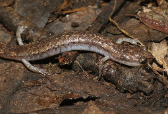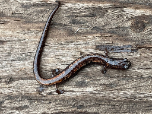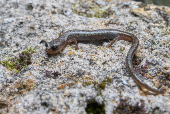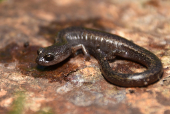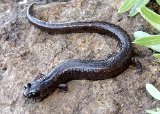 |
Channel Islands Slender Salamander Range Map
|
|
|
 |
 |
 |
 |
 |
 |
 |
Want to Contribute a photo of a Juvenile Channel Islands Slender Salamander?
Email Us
|
|
|
 |
 |
 |
 |
 |
 |
|
Channel Islands Slender Salamander (Batrachoseps pacificus)
Description: The Channel Islands slender salamander, like all slender salamanders, has short limbs, a narrow head, a lean body, and an especially elongated tail, as well as four toes on its feet. However, it has a more robust appearance than other slender salamanders due to its longer legs. Adults are 1.67 - 2.75 inches from snout to vent. Dorsal surface coloration ranges from brown to pinkish, with a prominent dorsal stripe made up of light speckles. The throat and underside of the tail are pale, while the abdomen appears whitish or slate with light and dark speckling. Its rib connections are indicated by a series of 18-20 costal grooves, which are clearly visible along with its end of torso grooves.
Habitat: On the islands where it occurs, the Channel Islands slender salamander occupies a wide range of habitats, including island coastal sage scrub, grasslands, chaparral, oak woodlands, pine woodlands, and, uniquely, beaches containing driftwood.
Range: Batrachoseps pacificus is endemic to the northern California Channel Islands, being found on San Miguel Island, Santa Rosa Island, Santa Cruz Island, and Anacapa Island. It is the only amphibian endemic to the islands off California.
Found in these States:
CA
Diet: The Channel Islands slender salamander likely eats an assortment of small invertebrates, such as earthworms, small slugs, terrestrial arthropods, and numerous insects, including insect larvae. It is probable that they use a projectile tongue to capture prey above and below ground.
Reproduction: Using burrows created by other animals or man-made crevices, eggs are laid underground by the female during late fall to winter, once they move down from the surface. Each egg set can consist of 13-20 eggs. After the offspring hatch, from winter to early spring, both adult and young salamanders return to the surface with rain the following fall and winter. There is significant variation in this cycle with meteorological fluctuations.
Status: Listed as Least Concern since, although its extent of occurrence is much less than 5,000 km2, it is common and occurs in an area of extensive, suitable habitat which appears not to be under threat and it has a presumed large population.
»» Kingdom: Animalia - Animals
»» Phylum: Chordata - Chordates
»» Subphylum: Vertebrata - Vertebrates
»» Class: Amphibia - (Amphibians)
»» Order: Caudata - Salamanders
»» Family: Plethodontidae - Lungless Salamanders
»» Genus: Batrachoseps
»» Species: Batrachoseps pacificus - Channel Islands Slender Salamander
This article uses material from the Wikipedia article "Channel Islands Slender Salamander", which is released under the Creative Commons Attribution-Share-Alike License 3.0. Content may have been omitted from the original, but no content has been changed or extended.
|
|



